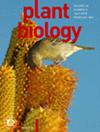巴西东南部三种雌雄异株Baccharis L.的性别空间分离预测和生活史理论。
IF 3.6
3区 生物学
Q1 PLANT SCIENCES
引用次数: 0
摘要
我报告了一项实地研究的结果,该研究测试了巴西东部高地共发生的三种雌雄异株Baccharis (L.)灌木物种的生活史理论和性别空间隔离的预测。双头蛇属是雌雄异株植物中种类最多的属之一,但对该属中雌雄异株的生态学意义了解甚少。基于Baccharis生物学,我对以下三个假设进行了统计分析:(1)性别比例及其与空间环境梯度的关系;(2)两性间生殖和营养分配的差异及其与环境梯度的关系;(3)在响应方面存在显著差异的可能性。我发现,其中一个物种,B. opuntioides,几乎满足了生活史理论和性别空间隔离的所有理论期望,而另一个物种,B. platypoda,满足了其中的一些要求,但没有满足其他要求。第三个物种,B. myriocephala,没有符合任何理论预期。对于肉芽头藻和鸭嘴藻,植物大小与雄性或雌性生殖或营养生物量分配的关系有时与生活史预测相反。早期的研究表明,Baccharis对雌雄异株驱动的资源分配和空间分离模式的预测不一致,可能是由属生物学的特质驱动的。我的研究在很大程度上支持了这一观点,但对Baccharis的理论预期进行更有力的测试,将需要更多地关注所研究的资源梯度的性质和长度,以及其他复杂因素,如开花高峰时期的种内差异。本文章由计算机程序翻译,如有差异,请以英文原文为准。

Testing predictions of spatial segregation of the sexes and life-history theory in three species of the dioecious genus Baccharis L. from southeastern Brazil
求助全文
通过发布文献求助,成功后即可免费获取论文全文。
去求助
来源期刊

Plant Biology
生物-植物科学
CiteScore
8.20
自引率
2.60%
发文量
109
审稿时长
3 months
期刊介绍:
Plant Biology is an international journal of broad scope bringing together the different subdisciplines, such as physiology, molecular biology, cell biology, development, genetics, systematics, ecology, evolution, ecophysiology, plant-microbe interactions, and mycology.
Plant Biology publishes original problem-oriented full-length research papers, short research papers, and review articles. Discussion of hot topics and provocative opinion articles are published under the heading Acute Views. From a multidisciplinary perspective, Plant Biology will provide a platform for publication, information and debate, encompassing all areas which fall within the scope of plant science.
 求助内容:
求助内容: 应助结果提醒方式:
应助结果提醒方式:


